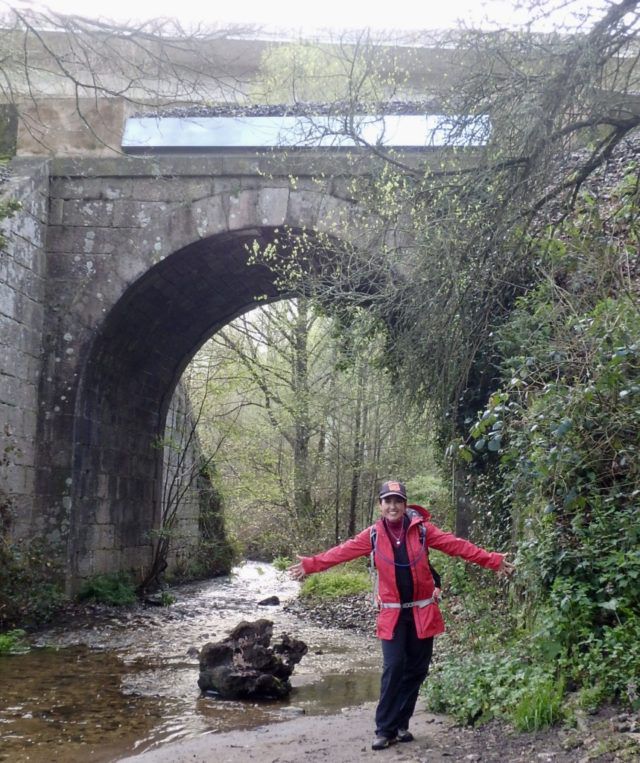 Why the Camino de Santiago?
Why the Camino de Santiago?
Listed as one of seven secular pilgrimages that will change your life by CNN, the Camino de Santiago (St. James Way) in northern Spain has been on my adventure list for years. This spring, a group of adventurous Camino Amigos and I joined forces to do the French Way.
Summary of Our Camino: The French Way – Sarria to Santiago

After careful planning to go in shoulder season, missing the crowds of July and August, last month, I and another fifteen adventurers from Florida, the Midwest, and Malaysia, set out on foot in Sarria with final destination Santiago de Compostela. This portion of the French Way took us six days to walk 114km. If one walks the entire journey from St. Pied du Pont it is approximately 485 miles and takes six weeks. However, with 100km you can do the trek and earn your diploma of completion in the Galician capital of Santiago de Compostela.
Galicia – Spanish Version of Ireland

Known as the rainy part of Spain, Galicia had experienced two months of non-stop rain before our arrival. Over our journey, we only experienced light rain the first day, but it remained dry and warm the rest of the way. Many pilgrims along the Camino said that it was those of us from South Florida that brought the much-needed sunshine with us. Regardless, we all packed rain gear and dry sacks each day knowing that our luck could run out at any point.
The French Way – Featured in the Movie The Way
 As an avid hiker, I would classify the French Way as a moderate hike. With that said, anyone including the very fit will feel the aches and pains of spending five to six hours on your feet. On our Camino, the shortest day was around eight miles with our longest being fifteen miles.
As an avid hiker, I would classify the French Way as a moderate hike. With that said, anyone including the very fit will feel the aches and pains of spending five to six hours on your feet. On our Camino, the shortest day was around eight miles with our longest being fifteen miles.
The GPS is Set on Santiago + Transformation
 All sixteen of us completed the Camino. Likewise, all did the Camino for some transformational reason whether related to health, relationships, religion, career or just to be inspired.
All sixteen of us completed the Camino. Likewise, all did the Camino for some transformational reason whether related to health, relationships, religion, career or just to be inspired.
If you are thinking of doing the Camino…
6 Travel Tips for a Buen Camino
Good Hiking Shoes
 The biggest way to be in the moment on the Camino is to have feet issues. To prevent blisters, hot spots, or other injuries, get yourself a good pair of hiking shoes. I wore two pairs of shoes along the journey: Colombia’s waterproof hiking boots and Mizuno running shoes. Both of these shows had hiked, ran, or walked hundreds of miles before the Camino. I also made sure to switch out my dry-wick or wool socks at lunch for another clean pair.
The biggest way to be in the moment on the Camino is to have feet issues. To prevent blisters, hot spots, or other injuries, get yourself a good pair of hiking shoes. I wore two pairs of shoes along the journey: Colombia’s waterproof hiking boots and Mizuno running shoes. Both of these shows had hiked, ran, or walked hundreds of miles before the Camino. I also made sure to switch out my dry-wick or wool socks at lunch for another clean pair.
Backpack with Bladder
 Although our Camino was in the cooler months, hydration is key for any long hike. I enjoy having my hands free; so, I use a 1.5-liter bladder that I filled in the morning. Thus, I didn’t have to fill up a water bottle nor purchase water along the Camino at the numerous cafes and stores in the small hamlets that you cross. Most packs that have a pocket for a bladder will also have straps to equally distribute the weight. Having a chest and waist strap is ideal for a comfortable long-distance hike. (**Photo above is of Finisterre, the end of the earth. We took a day-trip here as our treat after arriving in Santiago.**)
Although our Camino was in the cooler months, hydration is key for any long hike. I enjoy having my hands free; so, I use a 1.5-liter bladder that I filled in the morning. Thus, I didn’t have to fill up a water bottle nor purchase water along the Camino at the numerous cafes and stores in the small hamlets that you cross. Most packs that have a pocket for a bladder will also have straps to equally distribute the weight. Having a chest and waist strap is ideal for a comfortable long-distance hike. (**Photo above is of Finisterre, the end of the earth. We took a day-trip here as our treat after arriving in Santiago.**)
Rain Gear
 We were extremely lucky. It had been raining for two months straight before our arrival. We had one day of light rain. However, I brought my Colombia raincoat along each day as a warm layer as well as kept my rain pants in my backpack just in case. Northern Spain is known to be very rainy. The end of the Camino in Santiago is in Galicia, which is compared to Ireland because of the green pastures, temperatures, and rain.
We were extremely lucky. It had been raining for two months straight before our arrival. We had one day of light rain. However, I brought my Colombia raincoat along each day as a warm layer as well as kept my rain pants in my backpack just in case. Northern Spain is known to be very rainy. The end of the Camino in Santiago is in Galicia, which is compared to Ireland because of the green pastures, temperatures, and rain.
Hiking Poles
 If you are looking to maximize your distance and incorporate more muscles, use a pair of hiking poles. Traditionally pilgrims on the Camino used a staff with a gourd filled with water or wine. However, I would suggest getting two poles to utilize your arm muscles to push and pull you up the hills as well as to add speed to your flat trail areas. If you are a bit unstable on river crossings or walking on wet surfaces, the poles will help as well.
If you are looking to maximize your distance and incorporate more muscles, use a pair of hiking poles. Traditionally pilgrims on the Camino used a staff with a gourd filled with water or wine. However, I would suggest getting two poles to utilize your arm muscles to push and pull you up the hills as well as to add speed to your flat trail areas. If you are a bit unstable on river crossings or walking on wet surfaces, the poles will help as well.
Training with Your Gear
 I cannot emphasize the need to train and do it with your gear. Nearly none of the people that went with me on this last adventure did adequate training. There were many excuses, but most of the injuries along the Camino could have been prevented with adequate training as well as gear testing. Even if you live in an area without hiking trails, you can use the treadmill on an incline to make it like hills or if you have time and money to do some mini-getaways to hiking areas like Sedona, California, or other. I would recommend getting up to 8-15 miles with incline and gear to prepare you for your Camino.
I cannot emphasize the need to train and do it with your gear. Nearly none of the people that went with me on this last adventure did adequate training. There were many excuses, but most of the injuries along the Camino could have been prevented with adequate training as well as gear testing. Even if you live in an area without hiking trails, you can use the treadmill on an incline to make it like hills or if you have time and money to do some mini-getaways to hiking areas like Sedona, California, or other. I would recommend getting up to 8-15 miles with incline and gear to prepare you for your Camino.
Tiger Balm and Salonpas Patches
 I always suggest that you bring with you over the counter pain relievers such as Aleve or Ibuprofen. However, I also believe in topical pain relievers. My favorites that I don’t travel without are extra strength Tiger Balm which is great for your aches and pains from your hiking, walking, or climbing. I tend to get stress knots in my back, shoulders, and neck when I’m on long flights or bus rides. That’s why I use Salonpas patches that you can pinpoint a pain. Both remedies do have an odor, but if you are a seasoned traveler camphor and menthol smell a lot better than most backpackers.
I always suggest that you bring with you over the counter pain relievers such as Aleve or Ibuprofen. However, I also believe in topical pain relievers. My favorites that I don’t travel without are extra strength Tiger Balm which is great for your aches and pains from your hiking, walking, or climbing. I tend to get stress knots in my back, shoulders, and neck when I’m on long flights or bus rides. That’s why I use Salonpas patches that you can pinpoint a pain. Both remedies do have an odor, but if you are a seasoned traveler camphor and menthol smell a lot better than most backpackers.
Want to do the Camino this Oct 5-14th?
 There is another Camino de Santiago adventure planned for this fall, October 5th-14th. There are still spots available (1 shared room spot for a female as of 5/31/18). Secure your spot and learn more here. If those dates don’t work for you, I have something special for you. My trusted partner for the Camino, Camino Ways, has created a discount promo code for all of my readers. Just book online with code HEIDISIEFKASCAMINO for an additional 20 Euros off your Camino package.
There is another Camino de Santiago adventure planned for this fall, October 5th-14th. There are still spots available (1 shared room spot for a female as of 5/31/18). Secure your spot and learn more here. If those dates don’t work for you, I have something special for you. My trusted partner for the Camino, Camino Ways, has created a discount promo code for all of my readers. Just book online with code HEIDISIEFKASCAMINO for an additional 20 Euros off your Camino package.
If you have questions about the Camino, please ask in the comments below. AND, if you have done the Camino and have other travel tips or suggestions, please add them below as well.




